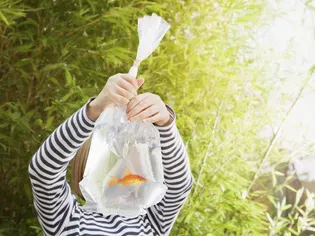Adding New Fish to an Aquarium
Updated on 04/26/24

Aquarium Oasis: A Comprehensive Guide to Introducing New Fish Harmoniously
Embarking on the exciting journey of adding new fish to your aquarium can be a fulfilling experience. However, meticulous planning and care are essential to ensure a smooth transition and the well-being of your aquatic inhabitants. This comprehensive guide will equip you with the knowledge and insights to navigate this process seamlessly.
Acclimatization: The Key to Success
Acclimatization is the crucial first step when introducing new fish to your aquarium. This process allows the fish to gradually adjust to the different water parameters in their new environment, minimizing stress and preventing potential health issues.
1. Float the Bag: Place the unopened bag containing the fish in your aquarium for 30-60 minutes. This allows the temperature of the water in the bag and the aquarium to equalize.
2. Open the Bag and Add Water: Carefully open the bag and pour out about half of the water into your aquarium sink. Then, over the next hour, gradually add aquarium water to the bag, while discarding the old water. This helps the fish acclimate to the new pH and hardness levels.
Quarantine: A Precautionary Measure
Quarantining newly acquired fish before introducing them to your established tank is a wise practice to prevent the spread of potential diseases or parasites. Designate a separate aquarium or container for quarantine and observe the fish closely for any signs of illness or abnormal behavior for 2-4 weeks.
Compatibility: Cohabiting Harmony
Before adding new fish, it's essential to research their compatibility with the existing inhabitants of your aquarium. Consider factors such as species compatibility, size differences, and environmental requirements. A well-matched fish community promotes harmony and reduces aggression.
For example:
* Peaceful Community Fish: Guppies, tetras, and zebrafish are generally peaceful and can coexist in a community tank.
* Semi-Aggressive Fish: Cichlids and angelfish can be semi-aggressive and may require a larger tank with plenty of hiding places.
* Aggressive Fish: Tiger barbs and Siamese fighting fish are highly territorial and should be kept separately or in tanks with similar species.
Water Quality: A Critical Factor
The water quality in your aquarium plays a significant role in the health and well-being of your fish. Before adding new fish, test the water parameters, including ammonia, nitrite, nitrate, pH, and temperature, and ensure they align with the requirements of the new species.
Stocking Density: Avoiding Overcrowding
Overcrowding can lead to stress, poor water quality, and increased competition for resources. Determine the appropriate number of fish to add based on the size of your aquarium and the specific species you intend to keep. A rule of thumb is one gallon of water per inch of fish.
Feeding and Nutrition: Nourishing New Arrivals
Provide the new fish with a nutritious diet that meets their specific needs. Research the dietary requirements of the new species and offer a balanced diet of live food, frozen food, and high-quality commercial fish food.
Monitor and Observe: Vigilant Care
After adding new fish to your aquarium, monitor their behavior and overall health closely. Observe for any signs of stress, such as hiding, erratic swimming, or loss of appetite. Address any concerns promptly and adjust the environment or provide additional care as necessary.
Conclusion
Adding new fish to an aquarium can enhance the beauty and diversity of your aquatic ecosystem. By following these comprehensive guidelines, you can ensure a smooth transition for your new inhabitants, promoting their health, well-being, and harmonious coexistence within your thriving underwater oasis.
Explore More Pets

Freshwater Aquarium Filters
How to Deal With Cloudy Aquarium Water

Saltwater Aquarium Filters
How Do You Remove Chloramines From Tap Water?

Freshwater Aquariums & Habitat
Can I Keep My Koi Fish Inside?

Saltwater Aquariums & Habitat
14 Best Floating Plants for Your Aquarium

Freshwater Fish Health
How to Treat Ich on Freshwater Fish

Saltwater Fish Health
Fin Rot in Aquarium Fish

Freshwater Aquarium Filters
How to Do Aquarium Water Changes

Saltwater Fish Health
How Do Fish Get Parasites?